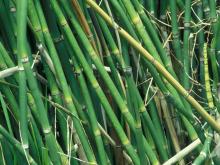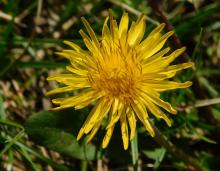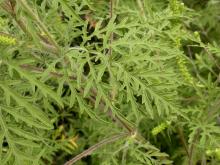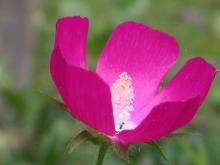Wildflowers, Grasses and Other Nonwoody Plants
Media

Species Types
Scientific Name
Equisetum (3 spp. in Missouri)
Description
Horsetails, or scouring rushes, are in the genus Equisetum. They’re easy to recognize with their jointed, hollow stems. Like ferns, they reproduce via spores instead of flowers and seeds.
Media

Species Types
Scientific Name
Asplenium platyneuron
Description
Ebony spleenwort is a common forest-floor fern with wiry, shiny, dark brown leaf stalks and a ladderlike series of dark green, narrowly oblong leaflets.
Media

Species Types
Scientific Name
Pellaea atropurpurea
Description
Purple cliff brake is a fern that grows from crevices in limestone and dolomite rocks, or in rocky soils near them. Its leathery, blue-gray leaflets, which are oval to lance-shaped, make the fronds seem not very fernlike.
Media

Species Types
Scientific Name
Pellaea glabella
Description
Smooth cliff brake is almost always seen growing out of an exposed limestone or dolomite bluff or rock. Its fronds, with blue-gray, lance-shaped, ovate, or oblong leaflets, are not very fernlike.
Media

Species Types
Scientific Name
Cystopteris protrusa (formerly C. fragilis var. protrusa)
Description
Lowland brittle fern, also called southern fragile fern, is an easily recognized species. It’s a common springtime sight in moist forest soils.
Media

Species Types
Scientific Name
Pteridium aquilinum
Description
Bracken is a fern found nearly worldwide. Its 2–3 times compound leaves are triangular in outline and arise singly from the underground creeping rhizome.
Media

Species Types
Scientific Name
Taraxacum officinale
Description
The common dandelion is a well-known common weed of lawns, roadsides, and other disturbed places. Originally from Europe, it occurs nearly worldwide.
Media

Species Types
Scientific Name
Chenopodium album
Description
Lamb’s quarters won’t win any beauty contests for its flowers, but it merits an award for being both a common garden weed as well as a nutritious leafy green valued around the world.
Media

Species Types
Scientific Name
Ambrosia artemisiifolia
Description
Common ragweed is instantly recognizable by its ornate, 2–3 times pinnately lobed, hairy leaves. You’ve probably seen it many times and wondered what it was.
Media

Species Types
Scientific Name
Callirhoe involucrata
Description
Purple poppy mallow, a native Missouri prairie wildflower, is a favorite of wildflower gardeners. It’s easy to care for and a showy choice for formal or informal landscaping.
See Also
About Wildflowers, Grasses and Other Nonwoody Plants in Missouri
A very simple way of thinking about the green world is to divide the vascular plants into two groups: woody and nonwoody (or herbaceous). But this is an artificial division; many plant families include some species that are woody and some that are not. The diversity of nonwoody vascular plants is staggering! Think of all the ferns, grasses, sedges, lilies, peas, sunflowers, nightshades, milkweeds, mustards, mints, and mallows — weeds and wildflowers — and many more!





















